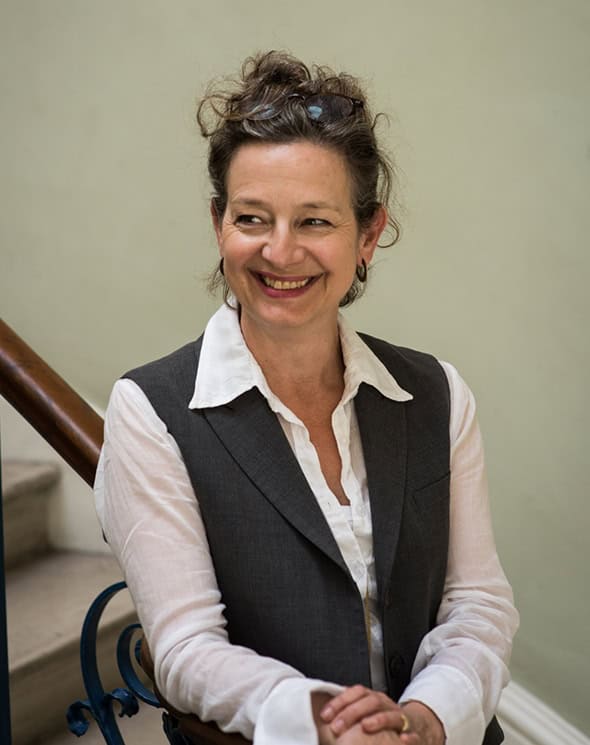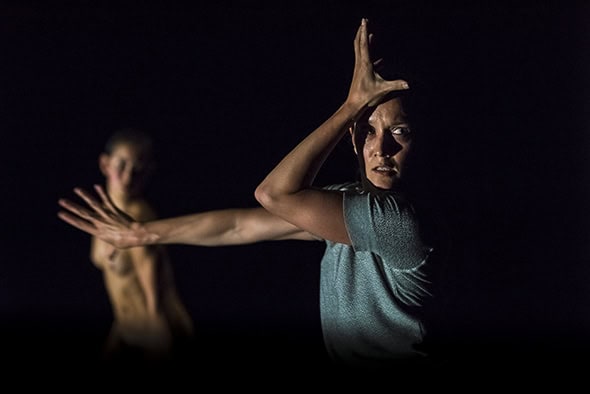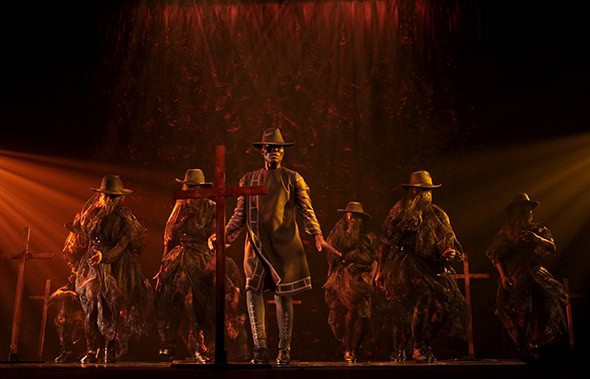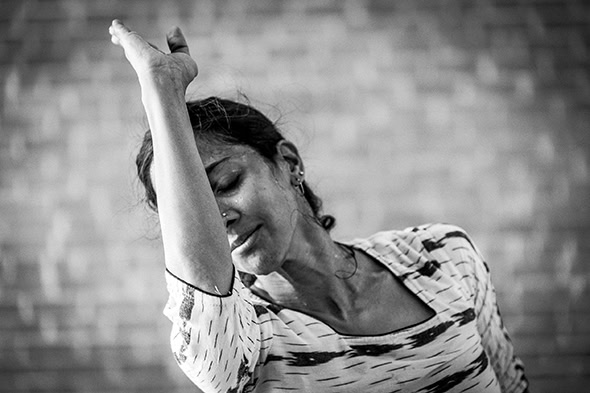Interview with Dance Umbrella’s Artistic Director, Emma Gladstone
Posted: September 30th, 2019 | Author: Nicholas Minns | Filed under: Festival, Interview | Tags: Amala Dianor, Dance Umbrella 2019, Emma Gladstone, Georgia Vardarou, Gisèle Vienne, Gregory Maqoma, Jacobsson and Caley, Jérôme Bel, Lucy Guerin, Mythili Prakash, Oona Doherty, Philippe Saire, Theaster Gates | Comments Off on Interview with Dance Umbrella’s Artistic Director, Emma GladstoneInterview with Dance Umbrella’s Artistic Director, Emma Gladstone, September 12

NM I read there’s a through-line to the 2019 Dance Umbrella festival focusing on ‘the emotional, intellectual and sensual power of the body’. I wonder if this focus is the result of the works you have chosen or if it is a pre-selected theme for this year?
EG I suppose I do like works that have structural concepts within them. Lucy Guerin’s Split is an example; it’s a pure dance piece but there’s a very clear structure of space and time in it that I think is not only a fabulous invention but also a guide to our watching. I feel there is more intellectual power and association and suggestion and connection in dance than people sometimes think. That’s why we do all the debates and talks during the festival; I think choreographers are such intelligent beings and so wide in their thinking and their invention that when they do find a way of working, or a particular discovery, it’s quite different from theatre.

NM Do you think dance has a place in intellectual and political discourse?
EG Yes, but I always think dance is not a good art form for facts, so you are always working more subtly and that includes the power of suggestion and connection for audiences while they are watching. There’s always going to be politics because of the body. But there are also many other things that can be revealed within the frame…
NM Do you think they are revealed during the performance or in discussing and thinking about it afterwards?
EG Well, if you take Jérôme Bel’s Gala, for example, it’s a hugely political work because of the journey on which it takes us, how it addresses our prejudices or assumptions and I love that evolution of our headspace while we’re watching. There’s also a big thing about difference, when international artists bring different worlds or different perceptions. In Gregory Maqoma’s CION for this year’s festival, you will hear an African choir singing Ravel’s Bolero and it makes you appreciate difference, hearing one of those rather hackneyed bits of music that are ‘owned’ in the western canon, how they can be used and treated and still be effective and moving and powerful from another world. To me difference is always part of the politics: looking at difference, understanding difference, not being afraid of difference. I think it’s something the art form as a whole can do very well. There’s something much more interesting for me about works that are full of politics through suggestion rather than flag waving.

NM Do you find this kind of content is more marked in works from outside the UK?
EG Oona Doherty is an interesting case for the questions of class and place she brings and reveals in her work (Hard To Be Soft at Southbank Centre and Hope Hunt and The Ascension Into Lazarus at The Yard Theatre). I think as an artform dance can also exist for its strength and beauty like music. There’s a wonderful American artist, Theaster Gates, who said in response to a question about the validity of art in a context of deprivations within society, “Beauty is a basic service”. I think there is a total validity in work that is for the human spirit alone. I don’t wish to negate that, but there is also the potential for insipid or empty works in the same way. I do search for complexity that includes intellectual ideas in the choreography, but there are so many different ways these can be realised.
NM What percentage of works that you see contain the ingredients you are looking for and find their way into your Dance Umbrella program?
EG I probably see about 180 works a year and there are usually 10 or 11 in a festival. But that 10 or 11 can include five or six commissions and then I don’t know what’s coming! These are artists I believe in who we’re keen to support and they’ll bring their work whatever it is, and we take that leap with them. For example, one of the works at the Linbury Theatre this year is Jacobsson and Caley’s reimagining of a Merce Cunningham piece, For Four Walls, and there are a couple of works in Freddie Opoku-Adaie’s Mixed Bill in his Out Of The System at Bernie Grant Arts Centre that are commissions. There are also two of the Four by Four Commissions, one chosen by Akram Khan — a new work by Mythili Prakash, Here and Now, at Croydon’s Fairfield Takeover — and the other by Anne-Teresa de Keersmaeker — Georgia Vardarou’s Why Should It Be More Desirable For Green Fire Balls To Exist Than Not? at the Lilian Baylis Theatre. I think it is part of our job to support artists and trust in them. That’s part of the fun. You’re asking people to take that leap with you and you get to see something at the start of a journey. I love those works that make me leave the theatre in a different place from where I went in; that’s what I want an audience to feel.

NM How do you see Dance Umbrella supporting the dance ecology in London?
EG One of the big decisions I made when I became artistic director was to bring over artists who are not already represented here. I felt liberated by the fact that most people don’t know most of the names most of the time, so it’s our reputation that we have to build through the quality of the work we present. Hopefully that means people will trust us and come to see fascinating artists because they appear under a banner whose quality audiences have come to value. Another decision was to stretch the diversity of choreographic expression as wide as possible, as with Charlotte Spencer’s Is This A Wasteland? in 2017 and Annie-B Parson’s 17c last year.
Another thing we are doing this year in Croydon and at the Opera House is working with our partners to put a mixture of work in a single frame; this is where I feel most responsible in terms of curating, figuring out what sits next to what, how will the audience see it after seeing something else. I’m excited by Amala Dianor’s work, Somewhere in the middle of infinity, at the Linbury, because he is in such an interesting place and the diverse training and styles of his three dancers contrasts with what Merce Cunningham is doing with his solid, single technique at the other end of the bill (Sounddance performed by CCN-Ballet de Lorraine). That’s why I like the title of the program, The Future Bursts In, that is taken from a 1964 Observer review of Cunningham’s first London performances. We have to look at works differently now; there are no longer those kinds of monolithic techniques.

NM How do you sift through the works you see to arrive at a Dance Umbrella program?
EG Apart from working on the diverse elements of age, culture, gender, and the geography of the city, I often invite those pieces I am not sure I liked at first, but which remain with me; they become milestones in my art journey of life. This is why I enjoy programming a festival rather than a venue; it’s the difference between the responsibility of programming year-round to develop a dance scene, with the growth over time of individual artists, and then the idea of a two-and-a-half week festival that’s about the new, the international. It’s a quite different focus, and it’s fun to play within that framework.
NM The geographical reach of the festival seems to have increased this year.
EG Yes, this is the most we have ever attempted. We have added the Royal Opera House — though it’s not a first for Dance Umbrella — because of the mix of audiences and the strength of the technique of the dancers in the program. And, of course, there’s four different locations in Croydon’s Fairfield Takeover. We are also developing our partnerships with festivals around the UK and internationally though we only tour within London; Philippe Saire’s Hocus Pocus is going to six venues around the city. I love that. This year the festival will embrace a total of 23 locations. It’s a bit mad!
NM In terms of the future?
EG This is my sixth year and I have no plans to be programming this festival years into the future. It’s a huge job, because it’s personal — art is personal; there’s no other way to do it. I love the job, and I love the team I am working with, but the scene is constantly changing and new, younger voices need to be heard. You can only reinvent your own wheel so many times.
Dance Umbrella runs from 8 – 27 October. Here’s the full program.